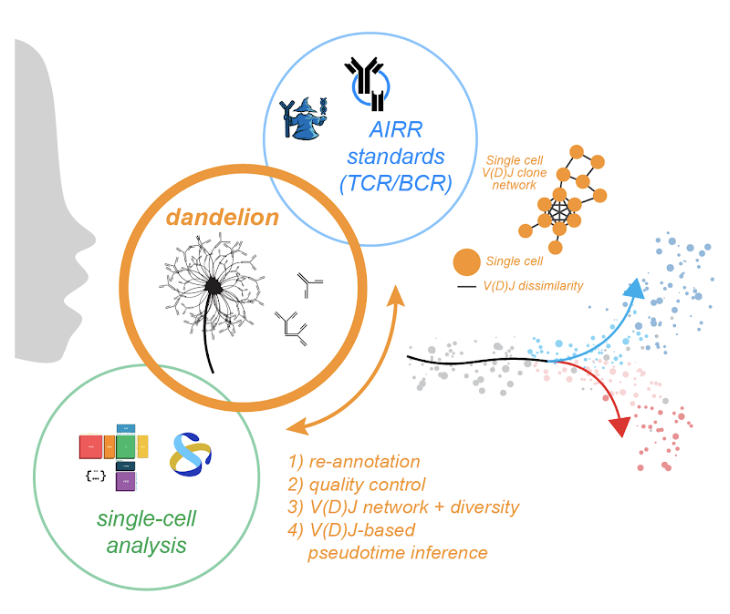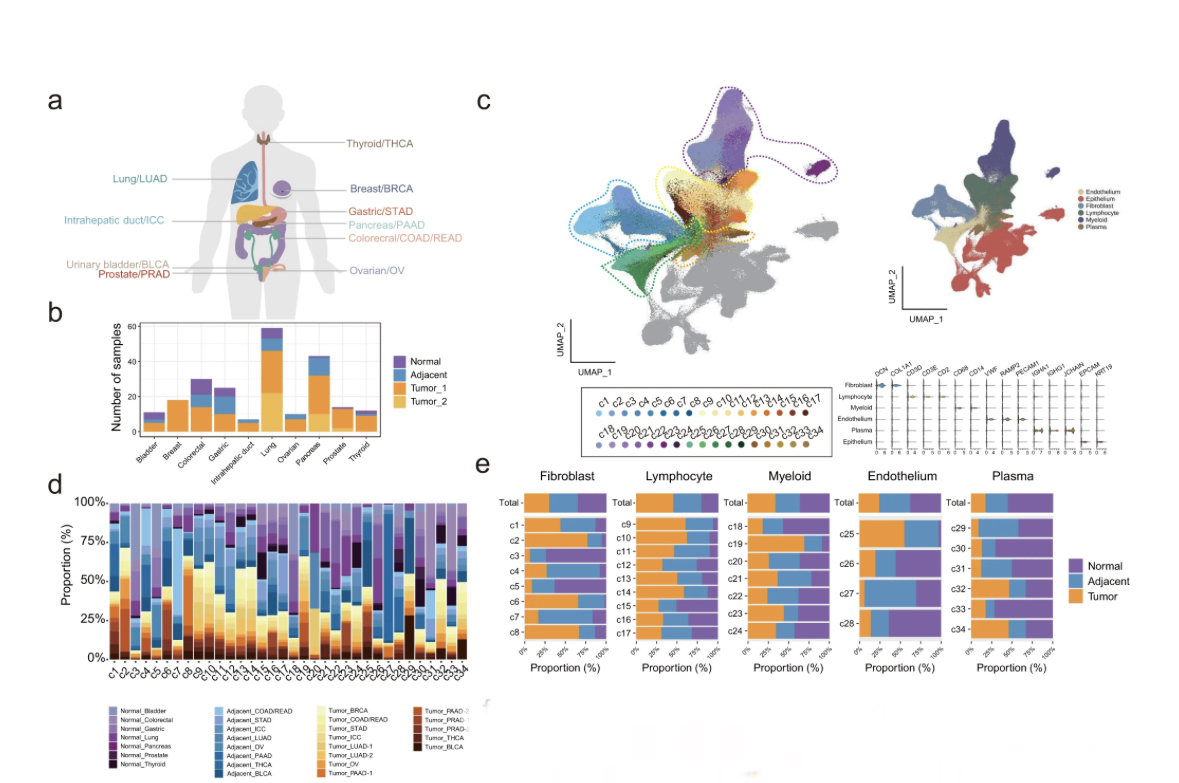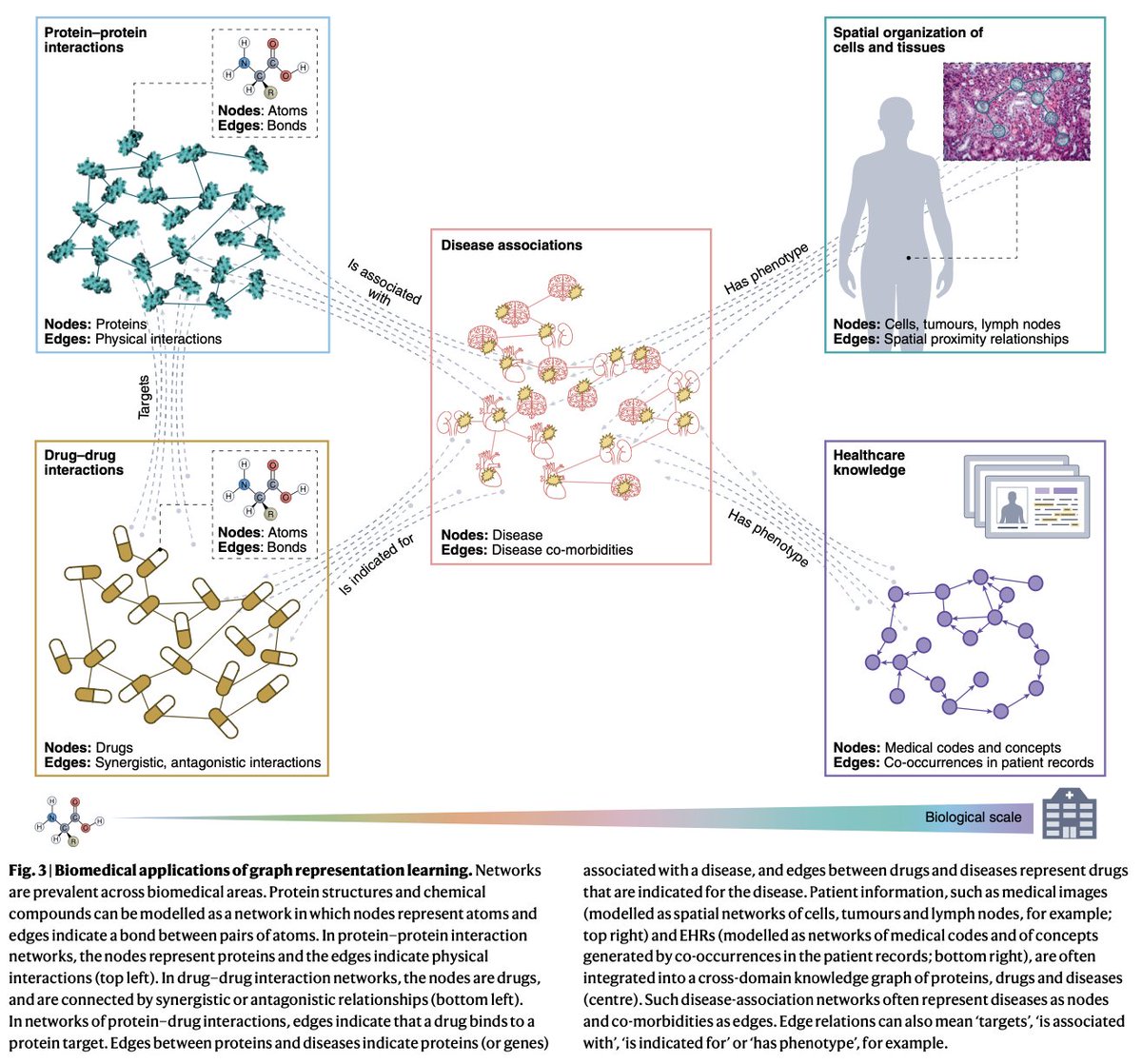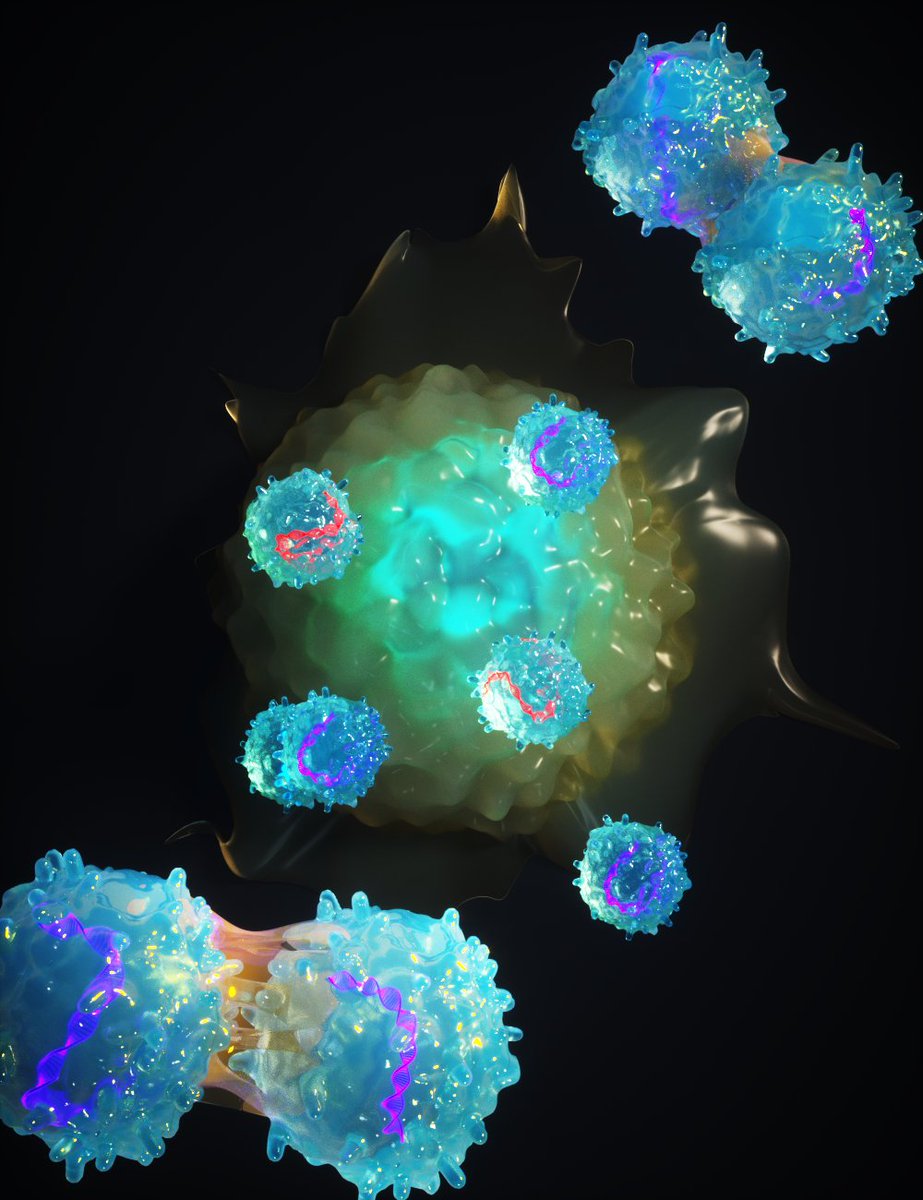Discover and read the best of Twitter Threads about #SingleCell
Most recents (24)
1/15 🧵 I'm thrilled to share the fantastic news that our Pan-Cancer T cell Atlas is now live @NatureMedicine nature.com/articles/s4159… @MDAndersonNews #SingleCell #SpatialOmics #TumorMicroenvironment #CancerImmunotherapy
2/15 🧵Our team has created a pan-cancer single-cell T cell atlas that integrates 27 scRNA sequencing datasets, including 9 unique datasets from @MDAndersonNews, covering 16 cancer types. It presents the most detailed picture to date of the heterogeneity of T cells within the TME
3/15 🧵We defined 32 T cell states in this study, and further identified 7 subpopulations within the CD4+ Treg subset, 5 within the CD4+ Tfh population, and 8 states among proliferating T cells.
1/ Are you a bioinformatics researcher looking for powerful tools to analyse your data? Check out @Bioconductor ! Here are some of my favorite packages for #bioinformatics analyses. 

2/ First up: #DESeq2 by @mikelove. This package provides a method for differential gene expression analysis of RNA-seq data. It's widely used and highly cited in the field, and it's perfect for identifying genes that are differentially expressed between samples.
3/ Next, I recommend #edgeR. Like DESeq2, edgeR is a package for differential gene expression analysis of RNA-seq data. It's particularly useful for smaller sample sizes and can detect differential expression with greater sensitivity.
In #biotech #stocks news, today we review $TXG @10xGenomics , one of the companies in the #SingleCell and #SpatialBiology sectors.
10x Genomics is a biotechnology company that develops and markets solutions for omics analysis of single cell and spatial biology samples. The company offers several product lines:
The Chromium platform is used for single-cell gene expression analysis, immune profiling, and genome sequencing. It allows researchers to study gene expression at the single-cell level, which can provide insights into cell behavior and disease progression.
In #JPM2023 news, $NSTG NanoString presented on January 11, 2023. Started in single-cell gene expression, now expanding into #SpatialBiology. They see a $3B+$3B market opportunity both on the NGS-based and the Imaging-based tech respectively. 

Sharing our latest paper in @Nature (nature.com/articles/s4158…), in which we ask whether non-hospitalized #COVID19 could change the status of the #immune system in ways that then impact future responses to a distinct perturbation, the #influenza #vaccine, long after recovery👇
We employ systems #immunology and #SingleCell multiomic approaches. Check out the reusable multimodal single cell, transcriptomics, circulating proteins and other data at: ncbi.nlm.nih.gov/geo/query/acc.… and doi.org/10.5281/zenodo…
This work, led by Rachel Sparks, William Lau, and Can Liu, took advantage of a unique opportunity and unprecedented epidemiological environment during the early fall of 2020, months after the first wave of COVID-19, when those with mild COVID-19 had recovered clinically, 👇
Our immune system is essential in keeping us healthy.
But the immune system also changes profoundly as we age.
Why is that? Could we prevent it?
Let's see how #singlecell biology can help us better understand #immune #aging
🧵👇
But the immune system also changes profoundly as we age.
Why is that? Could we prevent it?
Let's see how #singlecell biology can help us better understand #immune #aging
🧵👇
First, some background.
Everybody knows that the immune system is hugely complex.
#singlecell sequencing has (arguably) done more for the immune system than for other health applications.
Via #scRNAseq, we discovered & characterized crazily detailed immune cell phenotypes.
Everybody knows that the immune system is hugely complex.
#singlecell sequencing has (arguably) done more for the immune system than for other health applications.
Via #scRNAseq, we discovered & characterized crazily detailed immune cell phenotypes.

Such detailed phenotypes have been found in both healthy and diseased tissues.
I wrote several threads about this topic and find it to be one of the most foundational & fascinating progresses that have happened in biomedicine in the past 10 years.
I wrote several threads about this topic and find it to be one of the most foundational & fascinating progresses that have happened in biomedicine in the past 10 years.
#singlecell analysis is revolutionizing medicine and changing the way we look at disease.
New perspective article just out🚨@NatureMedicine reflecting on @humancellatlas: informative for both #singlecell lovers❤️& skeptiks🤔
Let's map out where the field stands & what is next🧵
New perspective article just out🚨@NatureMedicine reflecting on @humancellatlas: informative for both #singlecell lovers❤️& skeptiks🤔
Let's map out where the field stands & what is next🧵

First, some context.
The genomics single cell field has started out 1-2 decades ago with a huge promise:
"Find the missing link between genes, diseases and therapies. This will bring completely novel therapeutics to the market & cure disease."
The genomics single cell field has started out 1-2 decades ago with a huge promise:
"Find the missing link between genes, diseases and therapies. This will bring completely novel therapeutics to the market & cure disease."
The underlying logic is straigtforward:
1. the cell is the main unit of living organisms
⬇️
2. cells break down in disease
⬇️
3. understanding cells helps understand how & why they break
⬇️
4. this helps with engineering new therapeutics
⬇️
5. new therapeutics will cure disease
1. the cell is the main unit of living organisms
⬇️
2. cells break down in disease
⬇️
3. understanding cells helps understand how & why they break
⬇️
4. this helps with engineering new therapeutics
⬇️
5. new therapeutics will cure disease
Doing #SingleCell #RNAseq? Ever wonder if all those clusters are real? Turns out most feature selection & clustering pipelines can't tell when there's only 1 cluster! But I found a solution! 🧵👇 

Happy to release (and welcome feedback!) on my new feature selection algorithm that can help prevent false discoveries in scRNAseq datasets! bitbucket.org/scottyler892/a… (pip installable & works easily with scanpy :-) @fabian_theis
@fabian_theis By starting from first principles I asked: what is a cell type? We've long identified them as subsets of cells with different functions that have corresponding marker gene expression 

Its always difficult to take the first step, its always challenging to dive into a new domain. Happy that all the hard works brought the fruit eventually. Read our work from @RajeshPandeyLab @IGIBSocial @AcSIR_India on #singlecell #multiomics
The story highlights how important it is to understand the effect of #SARSCoV2 even after recovered from #COVID19 and how strength of #MachineLearning can be used for developing #disease #Biomarkers
This was indeed a challenging task, both on #Biology and #Bioinformatics front, but learnt a lot apart from the science part of it, especially #teamwork and #timemanagement.
#AcademicTwitter #AcademicChatter #phdlife
#AcademicTwitter #AcademicChatter #phdlife
We are thrilled to share #Starfysh ⭐️ an auxiliary deep generative model for multi-modal analysis and integration of spatial transcriptomic (ST) datasets and histology images, and its application to heterogeneous #breastcancer tumors! 😃 tinyurl.com/hffdhvx7 1/ 

Incredibly fortunate to have a passionate, collaborative & talented team that didn't slow down with all the challenges of the past few years 🙏: @SiyuHe7 @YinuoJin6, @AchilleNazaret @shi_lingting and a fruitful and ongoing collaboration with @GeorgePlitas and Sasha Rudensky. 2/
Using ST, we wanted to find out if our previously observed continuous phenotypic expansion of intratumoral immune states (doi.org/10.1016/j.cell…) could be explained by the #spatialdynamics of immune cells and exposure to different environmental signals and nutrient supply? 🧐 3/
Bringing V(D)J analysis to the single-cell space is difficult. We continued to developed dandelion to help with this, finding some interesting new biology along the way in this new pre-print! @Cambridge_Uni @sangerinstitute @ClatworthyLab @teichlab biorxiv.org/content/10.110…
One of things i felt strongly about when writing this was to try and acknowledge and respect the immense amount of work the #AIRR and #singlecell fields has put in to make it what it is today. So I came up with this summary illustration to conceptualise how dandelion can help. 

New🔥 #DataScience #Bioinformatics resource: 850,000‼️ #scRNAseq cells from 226 samples across 10 cancer types draw a map of the tumor microenvironment, in particular fibroblasts.
Let’s see👇what are the main contributions of this work & what this means for #cancer #Genomics🧵
Let’s see👇what are the main contributions of this work & what this means for #cancer #Genomics🧵

But first, some background.
Cancers are (unfortunately) complex ecosystems,consisting of various types of cells.
Malignant cells represent only a fraction of the tumor. The rest is made of the tumor microenvironment/TME (fibroblasts + immune cells), with complicated dual roles.
Cancers are (unfortunately) complex ecosystems,consisting of various types of cells.
Malignant cells represent only a fraction of the tumor. The rest is made of the tumor microenvironment/TME (fibroblasts + immune cells), with complicated dual roles.

Understanding the essence of this duality is key in understanding why most cancer therapies fail.
TME cells are plastic & can easily change states.
The same TME cells can either promote or suppress tumor development, depending on very subtle factors totally not well understood.
TME cells are plastic & can easily change states.
The same TME cells can either promote or suppress tumor development, depending on very subtle factors totally not well understood.
#GraphNeuralNetworks are way too cool to be left unexplored!
In a nutshell, GNNs are an exciting merger between graph theory (math) & #DeepLearning (coding).
Here's my detailed resource stack of best GNN theory explainers, videos & coding tutorials I used for my own learning.
In a nutshell, GNNs are an exciting merger between graph theory (math) & #DeepLearning (coding).
Here's my detailed resource stack of best GNN theory explainers, videos & coding tutorials I used for my own learning.
1. This is a great place to start if you either: want to learn the basics, or enjoy reading about basic concepts explained in a well structured way.
It walks us through graphs in real world, what graphs & GNNs consist of, and how GNNs do prediction.
distill.pub/2021/gnn-intro/
It walks us through graphs in real world, what graphs & GNNs consist of, and how GNNs do prediction.
distill.pub/2021/gnn-intro/

2. Further, this next tutorial walks us through graphs & GNNs in an intuitive manner, while also going quite deep into the specific mathematical terminology of the field.
I like this one a lot because it also includes hands-on PyTorch code at every step.
theaisummer.com/graph-convolut…
I like this one a lot because it also includes hands-on PyTorch code at every step.
theaisummer.com/graph-convolut…

🙌We are beyond excited to share our Perspective on graph representation learning for biomedicine and healthcare!🥳 @natBME @KexinHuang5 @marinkazitnik @HarvardDBMI
nature.com/articles/s4155… (1/4)

nature.com/articles/s4155… (1/4)


Graphs are pervasive in #biomedicine & #healthcare, from the molecular structure of proteins to population-scale healthcare systems!
We first describe the key algorithmic paradigms of graph representation learning & their successes and limitations in this space.
(2/4)
We first describe the key algorithmic paradigms of graph representation learning & their successes and limitations in this space.
(2/4)

We then carefully survey and highlight notable applications of graph representation learning in biomedicine and healthcare!
#molecules #diseases #therapeutics #histopathology #singlecell #precisionmedicine (3/4)
#molecules #diseases #therapeutics #histopathology #singlecell #precisionmedicine (3/4)

Amazing week for #DeepLearning in #spatial #singlecell biology, with 2🔥new Graph Neural Networks methods!
1.STELLAR🇺🇸 @jure: a cell type annotation & discovery atlas-type framework
2.NCEM🇪🇺 @fabian_theis: an approach to infer cellular communication patterns
Deep dive below🧵
1.STELLAR🇺🇸 @jure: a cell type annotation & discovery atlas-type framework
2.NCEM🇪🇺 @fabian_theis: an approach to infer cellular communication patterns
Deep dive below🧵

But first, some background.
Spatial molecular biology has actually been around since the 70s. @lpachter's wonderful book-like article "Museum of Spatial Transcriptomics" comprehensively discusses history, tech & methodology advances in the past 50 years.
nature.com/articles/s4159…
Spatial molecular biology has actually been around since the 70s. @lpachter's wonderful book-like article "Museum of Spatial Transcriptomics" comprehensively discusses history, tech & methodology advances in the past 50 years.
nature.com/articles/s4159…
Nevertheless, recent advances in single cell molecular technologies (brought by e.g. @10xGenomics & @AkoyaBio) have facilitated the high-throughout profiling of (groups of) single cells in their tissue context across embryogenesis, normal tissue development & disease progression.
In #biotech #stocks news, $TXG @10xGenomics is opening upwards +4% in today's trading. The company is down more than 75% in the 52-wk window. They peaked in Q1 2021 and have since then declined at a similar pace as other $XBI stocks out there. 



$TXG is in the #Singlecell and #Spatial biology field. They've recently made their pivot into Spatial Biology apparent, and have both an #NGS Next-Generation Sequencing and #InSitu imaging play on it, with their #Visium and #Xenium lines respectively. 

The $TXG top institutional holders include Morgan Stanley with less than 10%, followed by 3 of the heavy hitters in #biotech: UK's Baillie Gifford, Vanguard Group, and Black Rock. 

Excited to report that our latest work using snRNAseq to dissect the molecular basis of end-stage DCM and HCM is now published @Nature.
Large collaborative effort led by the incredibly talented Mark Chaffin @broadinstitute.
nature.com/articles/s4158…
Large collaborative effort led by the incredibly talented Mark Chaffin @broadinstitute.
nature.com/articles/s4158…
Building on previous work focused on the healthy heart (ahajournals.org/doi/10.1161/CI…), we sought to assess how cellular composition and transcription changes in failing hearts.
Working with Ken Margulies and Ken Bedi at @PennMedicine, we obtained left ventricular tissue from explanted hearts of 11 DCM and 15 HCM patients, along with 16 additional non-failing donor hearts.
Excited to share that our @NatureBiotech paper with Aviv Regev on Multicellular Programs (MCPs) is now out with a fully automated data-driven method to identify MCPs from #singlecell or spatial data #behindthepaper: go.nature.com/3iQ8fgW nature.com/articles/s4158… (1/19) 

Announcing TopOMetry, a dimensional reduction (DR) tool to learn #SingleCell data phenotypic topology. Finds >100 CD4 #Tcells in public blood data with very specific marker genes. You can use any method for visualization, such as MDE (@akshaykagrawal):
#bioinformatics
🧵1/16
#bioinformatics
🧵1/16
Pre-print just now on BioRxiv: biorxiv.org/content/10.110…
I'm still learning a lot, as I did this mostly on my own during my clinical rounds in pandemic Brazil. If you spot any mistakes or have comments, please be kind to reach out. I plan on improving.
2/16
I'm still learning a lot, as I did this mostly on my own during my clinical rounds in pandemic Brazil. If you spot any mistakes or have comments, please be kind to reach out. I plan on improving.
2/16
Really chuffed to share our latest work from Sanjana Lab out in @nature today (nature.com/articles/s4158…).
We tested >12,000 genes to find positive regulators of T cell proliferation to be used for next-gen #immunotherapies.
A thread...
We tested >12,000 genes to find positive regulators of T cell proliferation to be used for next-gen #immunotherapies.
A thread...

(2/28) T cell therapies have shown the potential to cure patients from #cancer – but even in B cell cancers, relapses outnumber cures… One of the problems is limited T cell persistence. #celltherapy #CARTcell
(3/28) We wanted to find new genes (including genes never expressed in T cells) that could improve T cell persistence. Now, the question was: should we use #crispr activation or directly deliver target genes on a #lentivirus?
Thrilled to announce my 1st paper from @stevens1lab is now published @NatureNeuro. “Dissection of Artifactual and Confounding Glial Signatures by scRNA-seq of Mouse and Human Brain”. Why is it important? a 🧵👇 #singlecell #microglia #methodsmatter 1/n
nature.com/articles/s4159…
nature.com/articles/s4159…
While the title frames this work in terms of brain, a KEY takeaway from new data in this version is that this is broadly applicable across basically all scRNA-seq (and RNA-seq) studies (especially in immunology)... 2/n
...and the artifact we discuss is unfortunately highly prevalent in current literature. So stick around even if brain isn’t your thing 😉. We thoroughly characterize the issue and provide a robust flexible solution to eliminate it as well. 3/n
Are you interested in how we can learn more human biology by integrating #singlecell genomics and #GWAS?
Please check out our preprint:
#V2F mapping at single-cell resolution through network propagation
biorxiv.org/content/10.110…
Led by @fulong_yu! A short 🧵 (1/n)
Please check out our preprint:
#V2F mapping at single-cell resolution through network propagation
biorxiv.org/content/10.110…
Led by @fulong_yu! A short 🧵 (1/n)

#GWAS have identified innumerable variants associated with disease, as shown in this recent @GWASCatalog plot, yet our understanding of the function of most variants is lacking. #V2F (2/n) 

With the increasing availability of #singlecell genomic atlases, such as the @humancellatlas, there are tremendous opportunities to systematically map variants to functional regulatory elements, which can be defined by accessible chromatin or epigenomic marks. (3/n)
Finally published in @naturemethods: CellRank for directed #SingleCell fate mapping, our take on studying cellular dynamics using RNA velocity. Fantastic collab between labs of @dana_peer @sloan_kettering and @fabian_theis @HelmholtzMunich, read at go.nature.com/3Fm17lt. 1/17
Motivation: scRNA-seq is great to study cellular heterogeneity, but its application to continuous processes is limited by the fact that cells are destroyed upon sequencing. Hence, we obtain many genes across many cells, but only through static snapshots. 2/17
1/ Excited to share how T cell therapies kill #leukemia!! multi-omics + new #computational #singlecell tools for longitudinal analysis 👉unexpected answer! cell.com/cell-reports/f…
*👏* @elhamazizi! 🙏 @dpeer Cathy Wu @MDAndersonNews @CPRITTexas @ColumbiaBME @sloan_kettering
*👏* @elhamazizi! 🙏 @dpeer Cathy Wu @MDAndersonNews @CPRITTexas @ColumbiaBME @sloan_kettering
2/ We studied donor lymphocyte infusion (DLI) - an #Immunotherapy for relapsed #leukemia after #BMT & the #og of #celltherapy. Previously, we showed DLI reversed T cell exhaustion - but didn't know why/how/which T cells were responsible...
ashpublications.org/blood/article/…
ashpublications.org/blood/article/…

3/ To address these ?'s, we modeled intraleukemic T cell dynamics by integrating longitudinal, multimodal data from ~100K T cells (!) during response (R) or resistance (NR: nonresponder) to DLI.







